#ISO Management System Standards
Explore tagged Tumblr posts
Text
🔄 Process Approach Across ISO & IATF Standards with 🚗 OEM Requirements in 2025
✅ Introduction: Why the Process Approach Matters in 2025 The process approach isn’t just a buzzword from ISO standards—it’s the engine behind operational excellence. As we step into 2025, OEMs (Original Equipment Manufacturers) demand more than compliance—they expect traceability, zero-defect culture, and real-time performance. In this guide, you’ll learn: 📌 How the process approach is defined…

View On WordPress
#5W2H model ISO#Automotive manufacturing#automotive quality system#clause 4.4 explained#EHS process compliance#energy management ISO 50001#environmental compliance ISO 14001#IATF 16949 process control#ISO digital integration#ISO standards 2025#lean manufacturing#occupational health ISO 45001#OEM compliance 2025#PFMEA process improvement#process approach ISO#process mapping ISO 9001#process ownership in QMS#quality management ISO 9001#risk-based thinking ISO#SIPOC diagram example#smart factory process control#Turtle diagram QMS
0 notes
Text
Role of ISO 14001 Standard in Preserving Biodiversity Across the Globe
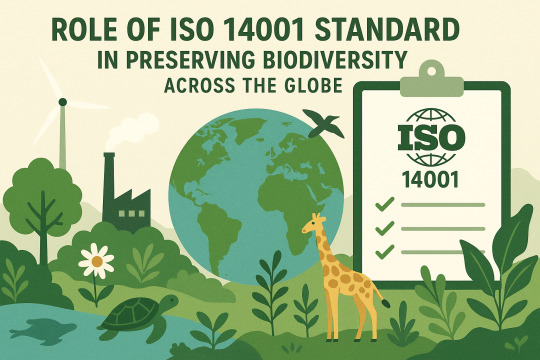
In an era of rapid industrialization, urban expansion, and climate change, the natural environment and biodiversity are facing unprecedented threats. Biodiversity—the variety of life forms on Earth—is essential for ecosystem services, climate regulation, food security, and human well-being. However, habitat destruction, pollution, and unsustainable practices have led to alarming declines in biodiversity worldwide.
To combat these threats, both governments and organizations must adopt responsible environmental management strategies. One such globally recognized framework is the ISO 14001 Environmental Management System (EMS). This standard provides a systematic approach for organizations to manage their environmental responsibilities, helping them minimize negative impacts and contribute positively to environmental preservation, including the critical goal of biodiversity conservation.
What is ISO 14001: A Brief Overview
ISO 14001 is part of the ISO 14000 family of standards developed by the International Organization for Standardization. It provides a structured framework that organizations can use to develop an effective environmental management system. The standard is applicable to businesses of all sizes and industries and emphasizes continuous improvement, legal compliance, and sustainable practices.
While the ISO 14001 Standard is not solely focused on biodiversity, its principles encourage the consideration of biodiversity as a critical component of environmental management. Through risk assessments, compliance obligations, stakeholder engagement, and performance evaluations, organizations can identify and mitigate their ecological footprints, including those that affect local ecosystems and species.
Biodiversity: A Critical Environmental Concern
Biodiversity includes the diversity of species, genetic variation, and ecosystems. Its loss leads to ecosystem degradation, which affects essential services like pollination, water purification, disease regulation, and climate resilience.
Businesses—especially those in sectors like agriculture, forestry, mining, and manufacturing—can significantly impact biodiversity through land use, pollution, waste generation, and resource extraction. ISO 14001 provides a pathway for these organizations to understand and manage their biodiversity-related impacts more effectively.
Key Ways ISO 14001 Supports Biodiversity Preservation
1. Identification of Environmental Aspects and Impacts
One of the first steps in ISO 14001 implementation is the identification of environmental aspects and their potential impacts. Organizations are required to assess how their operations interact with the environment, directly or indirectly. This process can uncover critical threats to biodiversity, such as:
Habitat destruction
Pollution of land and water
Introduction of invasive species
Disruption of local ecosystems
By recognizing these threats, businesses can take proactive measures to mitigate harm.
2. Risk Management and Mitigation
ISO 14001 emphasizes a risk-based approach to environmental management. This allows companies to assess the risks their activities pose to biodiversity and incorporate mitigation strategies into their operations. For example, a construction company working near a wetland may implement practices to protect native species, avoid breeding seasons, or restore habitats post-construction.
By aligning risk management with biodiversity goals, ISO 14001 facilitates the protection of ecosystems while ensuring business continuity.
3. Legal and Regulatory Compliance
Compliance with environmental laws and regulations is a core requirement of ISO 14001. Many countries have laws related to the protection of endangered species, ecosystems, and natural resources. The EMS framework helps organizations identify applicable biodiversity-related regulations and ensure adherence.
By avoiding legal penalties and fostering good relationships with regulatory agencies, ISO 14001-certified organizations can enhance their reputations while contributing to legal biodiversity objectives.
4. Continuous Improvement
The Plan-Do-Check-Act (PDCA) cycle at the heart of ISO 14001 encourages continual improvement. This means that biodiversity considerations are not one-time obligations but part of an evolving environmental strategy. Organizations can set objectives to reduce their ecological footprint, track performance metrics, and refine practices over time.
For instance, a manufacturing firm might initially aim to reduce water pollution affecting local fish species. Over time, it could expand its goals to include habitat restoration or native species monitoring.
5. Stakeholder Engagement and Transparency
ISO 14001 encourages organizations to engage with stakeholders—including communities, NGOs, governments, and customers—on environmental matters. This fosters dialogue about biodiversity issues and integrates local ecological knowledge into decision-making.
Publicly sharing biodiversity commitments and performance data builds trust and accountability, and can lead to valuable partnerships for conservation.
6. Sustainable Resource Use
The standard promotes sustainable use of natural resources, a practice essential for biodiversity conservation. By optimizing resource efficiency and reducing waste, businesses decrease pressure on ecosystems.
For example, an ISO 14001-certified company might adopt sustainable forestry practices that allow for timber harvesting while maintaining forest health and wildlife habitats.
Case Examples of ISO 14001 and Biodiversity Success
Unilever Unilever has integrated ISO 14001 across many of its facilities, incorporating biodiversity considerations into its agricultural supply chains. Through sustainable sourcing programs, the company has supported the conservation of critical ecosystems and reduced deforestation.
Toyota Toyota's global environmental policies align with ISO 14001 and include biodiversity targets. The company has established wildlife sanctuaries near its manufacturing plants and works to preserve local species through habitat management programs.
Heathrow Airport As part of its ISO 14001 EMS, Heathrow Airport monitors and protects local wildlife populations. It has implemented biodiversity action plans that include habitat enhancement and the protection of rare species near the airport perimeter.
Benefits of ISO 14001 for Biodiversity and Business
For Biodiversity:
Protection of endangered species and habitats
Reduction in pollution and habitat degradation
Promotion of ecosystem restoration
Support for conservation partnerships
For Organizations:
Enhanced corporate reputation and stakeholder trust
Better compliance with environmental laws
Operational efficiencies and cost savings
Reduced risk of environmental incidents
Access to green markets and investment opportunities
Challenges for ISO 14001 Implementation
While ISO 14001 provides a strong foundation, there are challenges in translating it into concrete biodiversity outcomes:
Not all organizations interpret biodiversity impacts thoroughly.
Certification may sometimes focus more on documentation than actual ecological improvement.
Smaller businesses may lack resources for in-depth biodiversity initiatives.
To overcome these challenges, organizations should:
Integrate biodiversity indicators into their EMS objectives.
Collaborate with conservation experts.
Invest in training and awareness for employees.
Conclusion
ISO 14001 Standard is more than a certificate on the wall—it is a practical tool for fostering responsible environmental stewardship. While it is not exclusively designed for biodiversity conservation, it creates the conditions necessary for businesses to understand, manage, and reduce their ecological impacts. By incorporating biodiversity into their ISO 14001 frameworks, organizations can play a vital role in safeguarding the planet’s rich biological heritage for future generations.
In a time of ecological crisis, aligning business practices with biodiversity goals is not just good for the environment—it is essential for long-term sustainability and resilience. ISO 14001 offers a pathway toward that future.
0 notes
Text
ISO 41001 and Employee Wellbeing - Facility Management System and Workplace Satisfaction

Introduction
In today’s competitive business environment, companies increasingly recognize the importance of employee well-being. This goes beyond just offering health insurance or gym memberships. A key contributor to employee satisfaction is the workplace environment itself, and one of the most effective frameworks for improving that environment is ISO 41001, the international standard for Facility Management (FM). By focusing on systematic approaches to facility operations, ISO 41001 helps create workspaces that foster productivity, comfort, safety, and overall employee well-being.
ISO 41001 in Brief
ISO 41001 is a globally recognized standard designed to optimize the management of facilities. It provides a structured approach to creating and maintaining an effective facility management system (FMS) that aligns with organizational goals. The standard outlines a set of requirements for organizations to ensure that their facilities are managed in a way that supports long-term sustainability, efficiency, and employee satisfaction.
Through its focus on continuous improvement and integration of stakeholder needs, ISO 41001 can help businesses enhance operational processes, reduce risks, and improve the work environment for employees.
Employee Well-Being in the Context of Facility Management
Employee well-being refers to the overall mental, physical, and emotional health of employees. It is a critical factor for workplace productivity and morale. Employees spend a significant portion of their lives in their workplace, so the design, maintenance, and functionality of their surroundings can have a direct impact on their health and satisfaction.
Facility management, when effectively implemented under ISO 41001, plays a vital role in enhancing workplace well-being by focusing on the following areas:
Health and Safety: The first and foremost priority in any workplace is ensuring the safety of employees. ISO 41001 requires that organizations maintain safe and healthy environments, minimizing risks from hazards such as poor air quality, excessive noise, fire safety, or inadequate lighting. The standard mandates proper maintenance of facilities and regular safety audits, ensuring employees are working in environments that are not only comfortable but secure.
Comfort and Ergonomics: ISO 41001 encourages facilities to be designed and maintained in a way that supports employee comfort. Elements such as climate control, appropriate lighting, and ergonomic furniture can significantly impact physical health and reduce the risk of musculoskeletal disorders. By focusing on optimizing office layouts, reducing noise levels, and controlling temperature, ISO 41001 helps create environments where employees can perform their best without being distracted or uncomfortable.
Air Quality and Ventilation: Poor air quality and ventilation are linked to a host of issues, such as fatigue, headaches, and reduced cognitive function. ISO 41001 emphasizes the importance of maintaining optimal indoor air quality through proper ventilation systems, regular maintenance, and the use of non-toxic building materials. Clean, fresh air contributes to better concentration, energy levels, and overall health, all of which positively influence employee satisfaction.
Workplace Flexibility: Modern workplaces are evolving to offer more flexible working conditions, such as adjustable desks, collaboration areas, and quiet spaces for focused work. ISO 41001 encourages facility managers to understand the changing needs of the workforce and ensure that the physical space supports different working styles. These adaptable workspaces contribute to a sense of autonomy, which is a significant driver of employee satisfaction and well-being.
Mental Well-Being and Stress Reduction: Beyond physical comfort, the mental well-being of employees is crucial. Stress can be a significant factor affecting workplace performance and satisfaction. ISO 41001 helps in creating peaceful, quiet environments, promoting work-life balance, and incorporating spaces for relaxation and breaks. Incorporating green spaces or providing access to natural light can also alleviate stress and improve mood, fostering a more relaxed and supportive workplace culture.
The Direct Link Between Facility Management and Employee Productivity
Employee productivity is inextricably linked to the environment in which they work. Poorly maintained or uncomfortable facilities can cause distractions, hinder performance, and even lead to higher absenteeism. By aligning facilities management with employee well-being, businesses can create a positive feedback loop: as employees experience a healthier, safer, and more comfortable workplace, their job satisfaction and engagement rise, directly impacting productivity.
A study by the World Green Building Council revealed that a well-designed office environment could boost employee productivity by up to 11%. ISO 41001 facilitates this by ensuring that the work environment is tailored to meet employee needs, enabling them to focus on their tasks and thrive.
Implementing ISO 41001 for Employee Wellbeing
Consider a company that has implemented ISO 41001 as part of its facilities management strategy. Through careful planning, the organization revamped its workspace, introducing better ergonomics, improved lighting, and a more flexible layout. The changes also included upgrades to air quality systems and the incorporation of quiet zones. After these changes, employee surveys indicated a significant improvement in satisfaction, with many reporting increased comfort and reduced stress levels. Additionally, absenteeism decreased, and productivity saw a measurable increase, demonstrating the tangible benefits of an ISO 41001-driven approach to workplace wellbeing.
Conclusion
ISO 41001 Facility Management System is a powerful tool that organizations can leverage to improve both the physical and mental well-being of their employees. By focusing on safety, comfort, air quality, flexibility, and stress reduction, ISO 41001 ensures that the workplace environment is conducive to employee satisfaction and productivity. With facility management as a core pillar of employee well-being, companies can not only enhance their workforce’s happiness but also foster long-term success. Implementing this standard is not just about maintaining buildings—it’s about creating spaces where people can thrive.
0 notes
Text
ISO 14001:2015 Environmental Management System Standard: A Complete Guide
Introduction
ISO 14001:2015 standard is the International standard for Environment Management Systems. It provides the proper platform for any organization in improving environmental performances through reduction of resource use and waste management. This standard could be applied to organizations of all sizes, irrespective of the nature of their activities, in proving environmental responsibility and compliance with legal and other requirements.
How to Understand ISO 14001:2015
ISO 14001:2015 lays down the requirements that can ensure appropriateness and adequacy of an EMS, hence certifiable. It sets out a framework which an organization should follow in order to have a successful environmental management system in place. ISO 14001 is based on a process approach rather than specifying the parameters relating to environmental performance.

Key Elements of ISO 14001:2015
This standard applies the Plan-Do-Check-Act cycle with some basic elements:
Context of the Organization: The organizations shall identify the external and internal issues related to their environmental responsibilities.
Leadership: The top management is responsible for the integration of EMS within the business strategy and compliance.
Planning: Identification of risks and opportunities, environmental aspects, compliance obligations, and objectives shall be done by the organizations.
Support: Resources, awareness of employees, and competency are required for the successful implementation of EMS.
Operation: Implementation of controls to manage environmental aspects, emergency preparedness, and response planning.
Performance Monitoring, measurement, analysis, and evaluation to enable continual improvement.
Improvement The organizations should implement corrective actions and continually improve EMS effectiveness.
Benefits of ISO 14001:2015 Implementation
ISO 14001:2015 implementation provides added advantages to the organizations in terms of:
Regulatory Compliance: It helps the organization to be compliant with environmental law and other related regulations in order to avoid fines and litigation cases.
Improved Environmental Performance: It promotes resource efficiency, waste minimization, and pollution prevention.
Cost Savings: Waste, energy, and water reductions all result in cost savings.
Improved Corporate Reputation: It shows good faith on issues relating to sustainability. This helps improve brand and consumer confidence.
Competitive Advantage: ISO 14001 certification has given many companies an edge over others by showing concern about the environment.
Employee Involvement: Encourages awareness and accountability within the organization for environmental concerns.
Steps to Achieve ISO 14001:2015 Certification
Gap Analysis: Compare current procedures to the needs of ISO 14001:2015.
Develop an EMS: Establish policies, objectives, and procedures that meet the needs of the standard.
Implementation: Apply EMS to routine activities, including the designation of responsibilities and training of employees.
Internal Audit: Internal audits shall be conducted to detect non-conformities and opportunities for improvement.
Management Review: Top management shall review the performance of EMS and make necessary improvements.
Certification Audit: An independent certification body will audit EMS for compliance and issue certification upon successful completion.
Common Challenges in ISO 14001:2015 Implementation
While ISO 14001:2015 implementation can turn out to be very effective, some challenges faced by the organization can be in the form of:
Lack of Awareness: Employees might not understand the need for an EMS, so they may resist.
Resource Constraints: Small businesses might have limitations on financial or human resources for the purpose of certification.
Documentation Management: The recordkeeping must be accurate and up-to-date.
Compliance Monitoring: Continual monitoring and evaluation are required to ensure continual compliance with regulatory requirements.
How to Overcome These Challenges
Organizations can overcome these challenges by:
Conducting regular training and awareness programs.
Providing appropriate resources for the implementation of EMS.
Using digital platforms for maintaining documents in a smooth way.
Implementation of compliances tracking system
Real-World Examples of Implementation of ISO 14001:2015
Organization of different sectors has achieved ISO 14001:2015 and obtained benefits from it. Some examples are as follows:
Auto-mobil industry: The leading four-wheeler manufacturers have embraced the ISO 14001 standard for lesser carbon footprints and judicious usage of energy.
Manufacturing industry: The manufacturing industry, iso 14001 was utilized to conserve the processes of manufacture through sustainable development and appropriate methods for waste disposal.
Healthcare: ISO 14001 also found its applications among the hospitals, and care providers in handling hazardous wastes along with fulfillment of the requirements and regulations related to the environment.
Hospitality Industry: Hotels and resorts have utilized the certificate in implementing environmentally friendly activities such as the conservation of water and efficiency in energy utilization.
Future of ISO 14001:2015
With increasing environmental concerns and stricter regulations, ISO 14001:2015 is expected to play a vital role in corporate sustainability. Organizations that proactively implement the standard will benefit from enhanced compliance, reduced risks, and improved stakeholder trust. As technology evolves, digital solutions like AI-driven monitoring systems and IoT-based environmental tracking tools will further streamline EMS implementation.
Conclusion
ISO 14001:2015 is one of the key standards that enable an organization to improve its environmental performance while ensuring that its operations are compliant with regulations. With an appropriately implemented and maintained EMS, a number of benefits an organization can achieve include cost savings, improvement in corporate image, and assurance of sustainable business. Certification demands commitment, planning, and continuous improvement; thus, it pays off in the long run.
Adoption of ISO 14001:2015 will go a long way in helping companies contribute much toward environmental sustainability, which ought to be beneficial to the organization itself and extend to the rest of the world. Proactive adoption, technologies, and attitude toward sustainable business practices will provide a future roadmap for environmental management; hence, ISO 14001 is a necessary tool for modern businesses globally. Visit https://www.abishekadhikari.com.np/ to learn more about ISO.
#iso 14001 certification#ISO 14001 Certification Services in Nepal#Environmental Management System Standard
0 notes
Text
#ISO 27001 audits#ISO 27001 certification#ISO 27001 training#requirements of the ISO 27001 standard#ISO 27001 internal audits#complete ISO 27001 implementation#training on IT Security Management System#ISO 27001 Consultant#ISO 27001 Consultancy Services
1 note
·
View note
Text
Business Continuity ISO Standard

Business Continuity ISO Standard
0 notes
Text
Guide to ISO 42001 in UAE: The First Global AI Systems Management Standard

ISO 42001 in UAE is the world's most memorable standard committed to AI Management System services. Its advancement denotes the worldwide acknowledgment of AI’s true capacity with the intricacies and challenges it brings, including ethical contemplations, transparency, and responsibility.
Key Components and Requirements
The center of ISO 42001 lies in its far-reaching way of dealing with AI management. It indicates requirements for:
Laying out an AI Management System that lines up with organizational objectives.
Implementing processes ensuring the responsible turn of events, sending, and support of artificial intelligence systems.
Keeping up with and consistently further developing AI systems to adjust to new challenges and open doors.
Tending to ethical contemplations, ensuring transparency, and advancing responsibility in AI applications.
The Certification Process Cycle
Obtaining ISO Certificate in UAE includes a few stages:
Gap Analysis: Review your ongoing information security practices against ISO 42001 requirements.
Planning: Foster a nitty-gritty arrangement to address recognized gaps.
Implementation: Lay out the essential cycles and controls.
Internal Audit: Direct internal audits to guarantee the ISMS fulfills the guideline's prerequisites.
Management Review: Ensure top administration audits and supports the ISMS.
External Audit: Go through an audit by an authorized certificate body.
Certification: Accomplish certification upon the effective finish of the external audit.
Role of Internal and External Audits
Internal audits are led by your association's own faculty to check the ISMS's viability and compliance. External audits are performed by a free certificate body to approve that your ISMS meets ISO 42001 requirements.
Documentation and Proof Required
Thorough documentation is pivotal for showing compliance. This incorporates approaches, methodology, risk approvals, and audit reports. Legitimate documentation gives an unmistakable symbol of your ISMS and is fundamental during the certificate audit.
Timetable and Key Achievements
The course of events for accomplishing certification can shift in view of your association's size and intricacy. Key achievements incorporate finishing the gap analysis, carrying out basic changes, conducting internal audits, and going through the external audit.
Benefits of ISO/IEC 42001 Certification
The advantages of AI Systems Management Standard certification are:
Improved Security: Fortified insurance of data resources.
Regulatory Compliance: Meeting and surpassing administrative necessities.
Expanded Client Trust: Showing areas of strength for information security.
Competitiveness: Hanging out in the market as a certified association.
Organization Reputation: Influence on organizational reputation and partner trust
The certificate signs to your clients and partners that your association seriously treats information security. This trust can prompt more grounded business connections and expanded client reliability.
Improvement in Operational Proficiency and Risk Management
Implementing ISO 42001 prompts better risk management and operational proficiency. The standard's organized strategy smoothes out processes and lessens the probability of safety incidents.
Implementation Techniques for Organizations
Practical tips and best practices:
Implementing ISO 42001 effectively requires an essential strategy:
Leadership Responsibility: Secure help from top administration.
Employee Commitment: Encourage a culture of safety mindfulness all through the association.
Clear Communication: Ensures everybody figures out the new approaches and techniques.
Ceaseless Monitoring: Consistently audit and update your ISMS to remain in front of dangers.
Role of Leadership and Worker Commitment
Initiative responsibility is basic for driving the execution cycle. Drawing in workers at all levels guarantees that security rehearses are followed and implanted in the hierarchical culture.
Significance of Continuous Monitoring and Improvement
An ISMS is definitely not a one-time project but a seamless exertion. Standard checking and improvement are fundamental to adjusting to developing dangers and changing business conditions.
General Challenges and Plannings
Associations might confront a few difficulties while taking on ISO 42001:
Resistance to Change: Employees might be reluctant to embrace new safety efforts.
Resource Limitations: Executing an ISMS can be a resource serious.
Complex Requirements: Understanding and satisfying every one of the guideline's requirements can overwhelm you.
Solutions and Techniques
To beat these challenges, think about the following methodologies:
Complete Training: Instruct workers about the benefits and needs of information security.
Allocate Resources: Ensure the undertaking is all-around subsidized and staffed.
Look for Professional Assistance: Make sure to with experts who work in ISO 42001.
Specialists suggest beginning with a careful risk assessment and taking on a staged way to deal with implementation. This aids in step-by-step constructing the ISMS and resolving issues as they emerge.
Conclusion
Understanding and executing ISO 42001 in UAE is a critical stage toward improving your association's info security. This guide gives a far-reaching outline of the standard, the certificate process, and the advantages of becoming insured.
By following these bits of knowledge and best practices, your association can accomplish a vigorous ISMS that safeguards your data resources, as well as build trust and reliability with your partners.
0 notes
Text
#ISO 27001:2022 Standard#Information Security Management System Certification#ISO 27001 Certification
0 notes
Text
How To Make Medical Device Quality Management System?
It is difficult to run a medical business without understanding the concept of a medical device quality management system. The International Organization for Standardization has set a framework for medical device manufacturers. They provide ISO 13485 certification to educate business organizations about their framework and its advantages.
Visit us - https://iso-standards.com/how-to-make-medical-device-quality-management-system/
#ISO Certification in USA#medical device quality management system#iso 13485 medical devices#iso 13485 requirements#iso 14001 certification#iso 14001 environmental management system#iso 14001 2015 standard
1 note
·
View note
Text
#ISO 50001 Certification in UAE#ISO Energy Management System#ISO 50001 Standard#ISO 50001 Documentation#ISO 50001 Implementation Guide
0 notes
Text
♻️ Mastering the PDCA Cycle in ISO 14001 – A Practical Guide to Environmental Excellence
Environmental management isn’t just about compliance—it’s about commitment. And the best way to embed this commitment into everyday operations? The PDCA cycle. Whether you’re just starting your ISO 14001 journey or enhancing your existing EMS, this blog breaks down the PDCA cycle with real-life examples, legal compliance tips, and a clear view of responsibilities. 🧩 What Is PDCA in ISO…

View On WordPress
#AD ISO Insights#Aspect Impact Analysis#business#Continual Improvement#Corrective Action#EMS#environment#Environmental Compliance#Environmental Management System#Environmental Objectives#Internal Audit#ISO 14001#ISO 14001 Clauses#ISO 14001 Implementation#ISO Blog#ISO Certification#ISO Standards#leadership#Legal Requirements ISO 14001#PDCA Cycle#PDCA Examples#Risk Assessment#sustainability#technology
0 notes
Text
Unlocking the Advantages for Organizations in Achieving Facility Management System
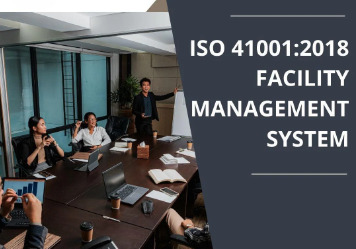
In the present quick-moving and fast-evolving business scene, efficient facility management is urgent for associations to flourish. One fundamental device that guides in accomplishing excellence in facility management is the ISO 41001 standard. ISO 41001 gives an extensive structure to laying out, executing, keeping up with, and further developing a Facility Management System.
ISO 41001 presents rules and best practices that assist organizations with upgrading their functional effectiveness, advancing resource portions, and ensuring the prosperity of employees and partners. By executing the standard, organizations can smooth out their FM processes, further develop efficiency, and decrease costs.
The advantages of embracing ISO 41001 are sweeping. It empowers associations to improve their dynamic cycles by giving a precise way to deal with overseeing offices. It likewise helps in recognizing possible threats and valuable open doors for development inside the association's FM practices.
What is a Facility Management System?
ISO 41001 Certification sets the measures for FMS norms. ISO 41001 ensure associations exhibit their capacity to carry out proper instruments and methods to improve the whole supply chain inventory network. It upgrades the production and efficiency of an association by incorporating individuals, spots, cycles, and innovations.
ISO 41001 for Facility Management principles follow the Annex SL structure and give a structure to developing, carrying out, and keeping a powerful worldwide FM system. The certification offers sustainable development to associations over the long haul.
10 Advantages of ISO 41001 Certification
The value FM region is projected to arrive at 1 trillion bucks by 2025. An expansion in esteem connotes the significance of a more sustainable Facility Management system. The International Organization for Standardization (ISO) has created the ISO 41001 Certificate to guarantee the productivity and viability of an FM system.
Realizing that your organization will acquire from a movement is inspiring and gives you the boost to happen until you accomplish it. At the point when ISO 41001 was first settled in 2018, it was finished because of the objections and issues that numerous facility managers were encountering around then. It was beneficial to bring together everything, so the whole world can communicate in one language in regard to the FM market. It would have not been smart to allow each association to carry out its own principles while laying out an FM System.
Facility Management is, regardless, the quickest developing area, something that extraordinarily required the improvement of the global principles that came to be known as ISO 41001. This standard was intended to be exceptionally helpful, and it has ended up being gainful to various associations. Here there is an examination of these advantages that you will acquire for being agreeable with ISO Standard for Facility Management.
The ten advantages presented by the ISO 41001 Certificate to associations are as per the following:-
Maintains Regulatory Compliance: The principles are not a piece of any regulation; consequently, there are no punishments in the event of rebelliousness. Notwithstanding, it intends to further develop the FM system and guarantee compliance with every one of the guidelines and norms connected with FMS.
Provides Opportunity: Associations that are certified, exhibit the obligation to consistently further develop their monetary service administrations. It gives an upper hand to associations and assists them with winning new organizations, customers, and clients.
Better Standing: ISO 41001 improves the standing of an association. It lays out a culture of safety and security inside the association and works on its presentation.
Increases Attractiveness & Productivity: It expands the attractiveness and productivity of associations. The guidelines guarantee that the FM delivered by an association is protected and makes a useful working environment.
Access to Global Market: An FM system standard eliminates exchange boundaries and gives admittance to the worldwide market. It shows an association's capacity to consolidate globally accepted procedures inside its administration system.
Cost-Competitive Standard: The certification is a practical norm. It saves the additional expenses paid as pay sums and charges by improving labor force efficiency, security, safety, and prosperity.
Strategic Methodology: The certified associations follow an essential methodology and give certification and positive worth to partners. It guarantees that the business tasks are risk-explicit and exceptionally proficient.
Dynamic Standard: It empowers an association to adjust to the always-changing patterns in infrastructural advancement and take on apparatuses and methods to likewise oversee them.
Risk-Based Approach: Associations with an ISO 41001 endorsement follow a risk-based approach. It assists associations with deciding the expected threats and opening doors related to the FM system.
Employee Experience: It expects to give a superior encounter to workers. The standard plans to lay out steady, reasonable, and useful work environments.
Conclusion
All in all, accomplishing the Facility Management System Certification offers a huge number of benefits for associations planning to lift their functional greatness and expand the proficiency of their offices. By sticking to perceived principles, for example, ISO 41001, organizations can open a scope of advantages, including further developed facility execution, upgraded risk management, expanded sustainability, and more prominent arrangements with administrative requirements.
Besides, a certificate encourages a culture of constant improvement, driving associations to refine their FM practices and adjust to developing requirements and difficulties. As associations embrace the standards of powerful FM certificates, they position themselves for long-haul achievement, driving worth, flexibility, and fulfillment across their activities and partner networks.
0 notes
Text
ISO 9001 is based on seven standards of quality management and attempts to help organizations be more efficient and enhance customer satisfaction. One prevalent confusion is that ISO 9001 is only for major corporations and manufacturers. However, the ISO 9001 criteria are generic and apply to any organization, regardless of its nature, size, or the products or services it delivers.
Small businesses are difficult to run. Why? Because a small group of individuals is seeking so many work duties at the same time, such as government regulations, laws, production and sales, supply chains, financial concerns, issues with quality, the labor force, and so on. Consistent quality services are what can enable a small business to become a viable and constantly growing organization. Consistency in procedures, quality, and systems will allow small businesses to consider bus improvements.
#ISO 9001#ISO 9001 Certification#ISO 9001 Manual#ISO 9001 Documents#Quality management System#Quality#ISO 9001 standard#ISO 9001 Audit#ISO 9001 Audit Checklist
1 note
·
View note
Text

#ISO 44001 standard#iso 44001 lead auditor training course#iso 44001 certification#online iso 44001 lead auditor training course#Collaborative Business Relationship Management System
0 notes
Text
ISO 17025

0 notes
Text
Have YOU got an old Windows PC Microsoft has told you can't run Windows 11? It's time to give it a new life!
How to install Windows 11 on unsupported PC Hardware using Rufus. You can also disable some other Windows 11 bullshit like data harvesting and needing a Microsoft account.
It has been in the news a lot lately that Windows 11 isn't allowed to be installed on PCs without certain requirements, including the TPM 2.0, a chip that was only included in PCs made in 2018 or later. This means that once Windows 10 stops receiving security updates, those PCs will not be able to (officially) run a safe, updated version of Windows anymore. This has led to an estimated 240 million PCs bound for the landfill. Thanks Microsoft! I get you don't want to be seen as the insecure one, but creating this much waste can't be the solution.
(I know nerds, Linux is a thing. I love you but we are not having that conversation. If you want to use Linux on an old PC you are already doing it and you don't need to tell me about it. People need Windows for all sorts of reasons that Linux won't cut.)
So lately I have been helping some under privileged teens get set up with PCs. Their school was giving away their old lab computers, and these kids would usually have no chance to afford even a basic computer. They had their hard drives pulled so I have been setting them up with SSDs, but the question was, what to do about the operating system? So I looked into it and I found out there IS actually a way to bypass Microsoft's system requirement and put Windows 11 on PCs as old as 2010.
You will need: Rufus: An open source ISO burning tool.
A Windows 11 ISO: Available from Microsoft.
A USB Flash Drive, at least 16GB.
A working PC to make the ISO, and a PC from 2018 or older you want to install Windows 11 on.
Here is the guide I used, but I will put it in my own words as well.
Download your Windows 11 ISO, and plug in your USB drive. It will be erased, so don't have anything valuable on it. Run Rufus, select your USB drive in the Device window, and select your Windows 11 ISO with the Select button. (There is supposed to be a feature in Rufus to download your ISO but I couldn't get it to work.?
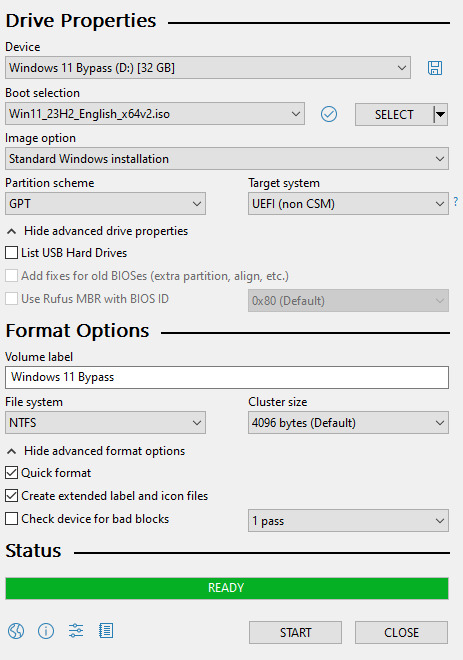
Choose standard windows installation, and follow the screenshot for your settings. Once you are done that, press Start, and then the magic happens. Another window pops up allowing you to remove the system requirements, the need for a microsoft account, and turn off data collecting. Just click the options you want, and press ok to write your iso to a drive.
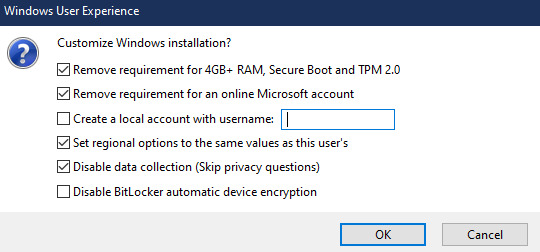
From there you just need to use the USB drive to install windows. I won't go into details here, but here are some resources if you don't know how to do it.
Boot your PC from a USB Drive
Install Windows 11 from USB Drive
If you had a licensed copy of Windows 10, Windows 11 will already be licensed. If you don't, then perhaps you can use some kind of... Activation Scripts for Microsoft software, that will allow you to activate them. Of course I cannot link such tools here. So there you go, now you can save a PC made from before 2018 from the landfill, and maybe give it to a deserving teen in the process. The more we can extend the lives of technology and keep it out of the trash, the better.
Additional note: This removes the requirement for having 4GB Minimum of RAM, but I think that requirement should honestly be higher. Windows 11 will be unusable slow on any system with below 8GB of RAM. 8GB is the minimum I think you should have before trying this but it still really not enough for modern use outside of light web and office work. I wouldn't recommend trying this on anything with 4GB or less. I am honestly shocked they are still selling brand new Windows 11 PCs with 4GB of ram. If you're not sure how much RAM you have, you can find out in the performance tab of Task Manager in Windows, if you click the More Details icon on the bottom right. If you don't have enough, RAM for old systems is super cheap and widely available so it would definitely be worth upgrading if you have a ram starved machine you'd like to give a new life.
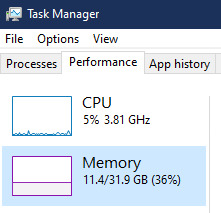
#Windows#Windows 11#tech#tech advice#pc#TPM 2.0#rufus#open source#open source software#technology#tech tips
725 notes
·
View notes